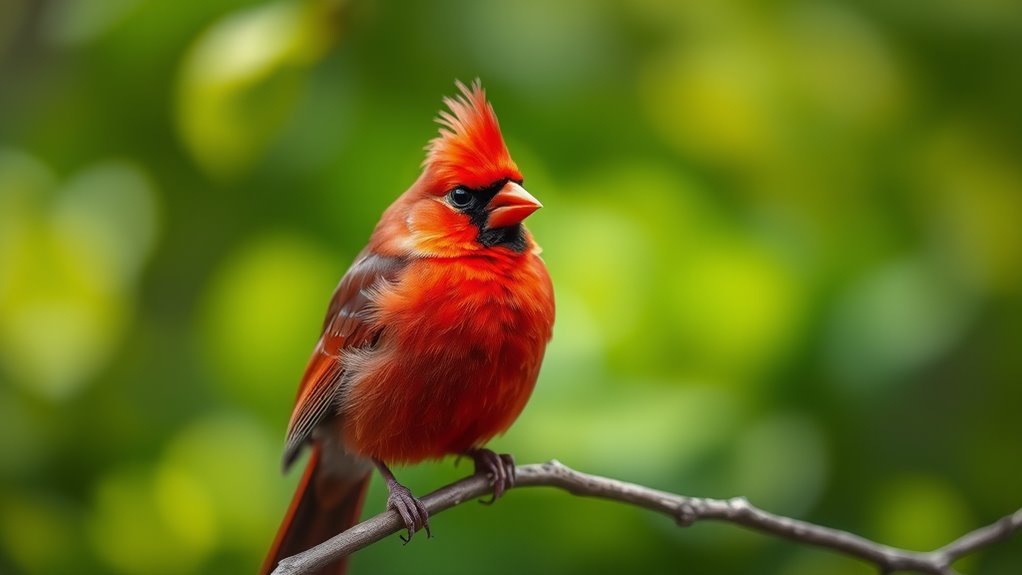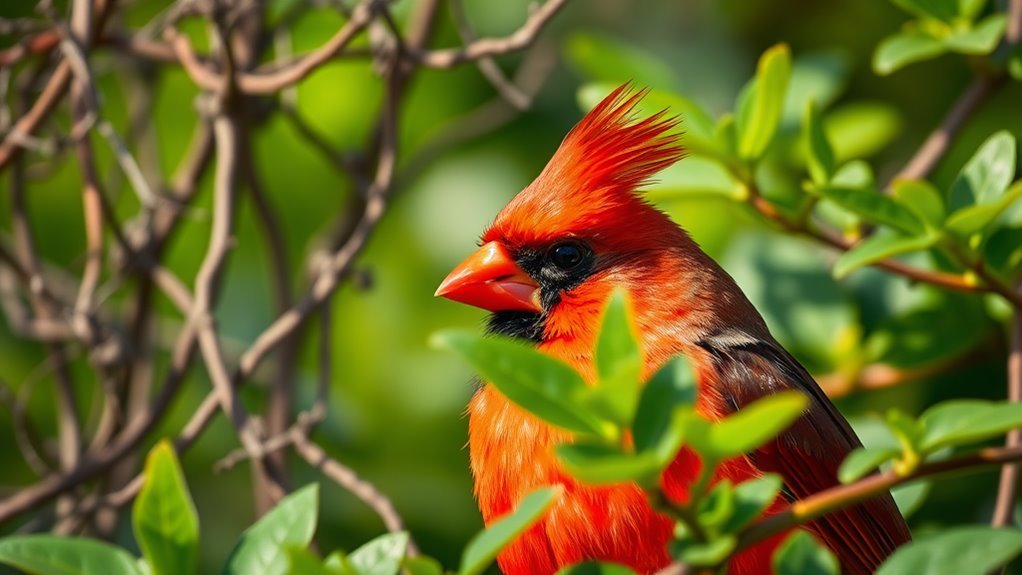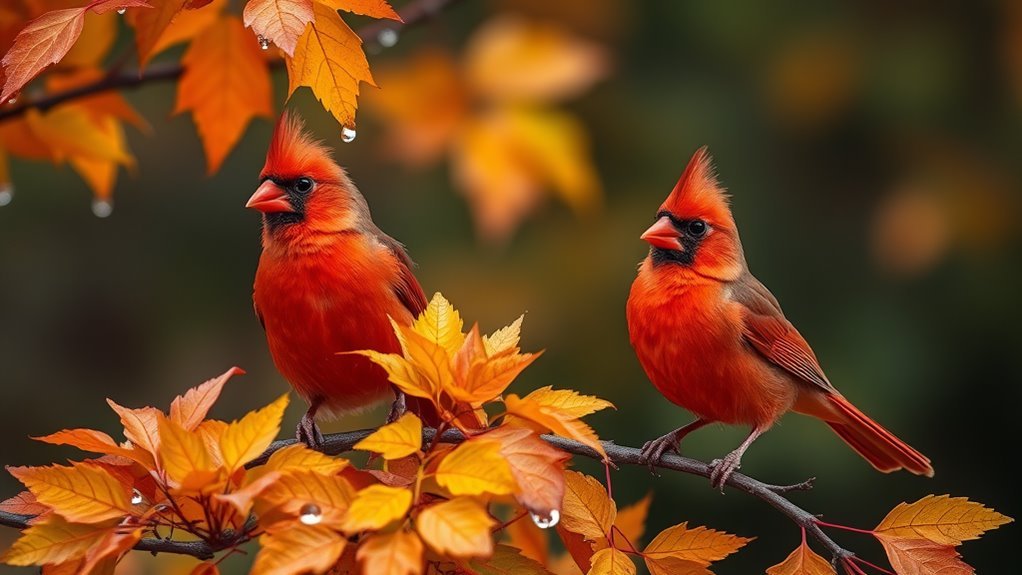Cardinals Without Crests: Rare Conditions Explained
When you see a cardinal without its crest, it prompts questions about why this happens. These cardinals may have genetic mutations or face environmental stress. The lack of a crest can affect their ability to attract mates, which may impact their population. Learning about these rare cases helps us understand bird traits and the conditions needed for their habitats. How might these insights influence conservation efforts?
Key Takeaways
Crest loss in cardinals can occur due to genetic changes that affect feather growth and color. Environmental factors, such as changes in habitat or climate, can also influence crest development and the bird's overall health. A nutritious diet is important for maintaining healthy crests; lacking essential nutrients can lead to cardinals without crests.
Cardinals without crests may show different social behaviors. They might find it harder to attract mates and successfully breed. Studying these crestless cardinals helps researchers learn about the role of crests in bird communication and social interactions. Understanding these aspects can provide insights into the health and behavior of cardinals in their natural environments.
Understanding Cardinal Plumage and Crest Development

Cardinals have bright plumage that's influenced by genetics and the environment. Their colors can show health and maturity, which are important for mating.
Male cardinals typically have vivid red feathers that attract females. The crest on their heads acts as a visual marker and a way to communicate. This crest can also signal dominance and social status within their groups.
Factors such as diet, habitat, and seasonal changes can affect these characteristics, highlighting the connection between cardinals and their environment. Their beauty and adaptations contribute to their success in various habitats.
Genetic Mutations and Their Impact on Cardinals
Cardinals show various genetic mutations that change their appearance and behavior. These mutations add diversity to cardinal populations and create unique feather colors and patterns. For example, a mutation can change melanin production, leading to cardinals with lighter or darker feathers than usual. This change can make them visually striking and help identify individual birds.
Some mutations also affect behavior or song, changing how they interact socially. Learning about these genetic differences can increase your appreciation for cardinals.
It also emphasizes the need to protect their habitats. Preserving these habitats helps maintain genetic diversity, supporting healthier and stronger cardinal populations.
Environmental Factors Affecting Crest Formation

Genetic factors influence crest formation in cardinals, but environmental factors are also important.
Changes in habitat, like urban development and deforestation, can harm conditions needed for healthy crest growth. When cardinals experience altered environments, their stress levels may rise, which can affect feather development.
Climate change also impacts cardinals. Temperature changes and extreme weather events can make it harder for them to form crests.
Research shows these stressors can lead to fewer resources and more competition for breeding. This can negatively impact their physical features.
Understanding these environmental factors helps us see the importance of preserving habitats for cardinals. By protecting their environments, we can support the growth of these beautiful birds and their crests.
The Role of Nutrition in Avian Crest Development
Nutritional intake significantly affects crest development in birds, especially cardinals. A balanced diet provides essential nutrients needed for proper crest formation. Nutritional deficiencies can lead to issues like abnormal crest development or crest loss.
Key nutrients for optimal crest growth include:
- Proteins: These are crucial for feather growth.
- Vitamins A and E: These vitamins support skin health and pigmentation.
- Minerals like zinc and calcium: These are important for feather structure and integrity.
Observational Cases of Crestless Cardinals

Crestless cardinals present an interesting case for researchers. Their lack of a crest may seem unusual, but it can affect their health and behavior. Observations show that these birds change how they interact socially.
For example, crestless cardinals may have different feeding habits and nesting choices. These changes can influence their overall health and survival.
Breeding patterns also reveal challenges for crestless cardinals. Without a crest, they may have a harder time attracting mates. Crests typically play a key role in a bird's appeal to potential partners. This reduction in mate selection can impact their reproductive success.
Studying these behaviors helps us understand the effects of crest loss on individual birds and the wider bird population. This information highlights the importance of physical traits in the lives of cardinals.
Conservation and the Importance of Unique Cardinal Characteristics
Researchers find unique cardinal characteristics important for bird conservation. These traits, like crest variations, help birds choose habitats, attract mates, and interact socially.
Key points include:
- Unique adaptations support genetic diversity in populations.
- Understanding these traits aids in creating specific conservation plans.
- Protecting habitats keeps both the birds and their distinct traits safe.
Frequently Asked Questions
Can Crestless Cardinals Still Reproduce Successfully?
Crestless cardinals can reproduce successfully. Their breeding success relies on genetic differences that affect their mating choices and overall health. Understanding these factors helps us learn more about bird adaptation and diversity.
Are There Certain Regions With More Crestless Cardinals?
Yes, there are regions with more crestless cardinals. Their habitat affects crest development. Certain environments may lead to a higher number of crestless cardinals in specific areas.
Do Crestless Cardinals Behave Differently Than Regular Cardinals?
Crestless cardinals behave differently from regular cardinals. They are often less dominant in social settings. This can make them more cautious. Their behavior may affect how they fit into groups and interact with other birds. Overall, crestless cardinals show unique traits that influence their social dynamics.
Can Other Bird Species Experience Similar Crestless Conditions?
Yes, other bird species can have crestless conditions due to abnormalities. These species may face special challenges and develop unique behaviors. Their adaptations can affect how they interact with their surroundings. This topic often interests bird enthusiasts and raises questions about avian health.
How Do Birdwatchers Identify Crestless Cardinals in the Wild?
To identify crestless cardinals, focus on clear visual signs. Look for their body size and color patterns. Listen for their unique vocal sounds. These details will help you spot these birds among the more common species in nature. Enjoy the process of observing and learning about these fascinating creatures.

Ava is a bird enthusiast and nature lover who has spent countless hours observing and learning about the fascinating world of birds. With a passion for sharing her knowledge and inspiring others to appreciate the beauty of birds, Ava writes about her experiences and insights on avianadmirer.com.







